pressure Lancia Ypsilon 2017 Owner handbook (in English)
[x] Cancel search | Manufacturer: LANCIA, Model Year: 2017, Model line: Ypsilon, Model: Lancia Ypsilon 2017Pages: 200, PDF Size: 4.53 MB
Page 16 of 200
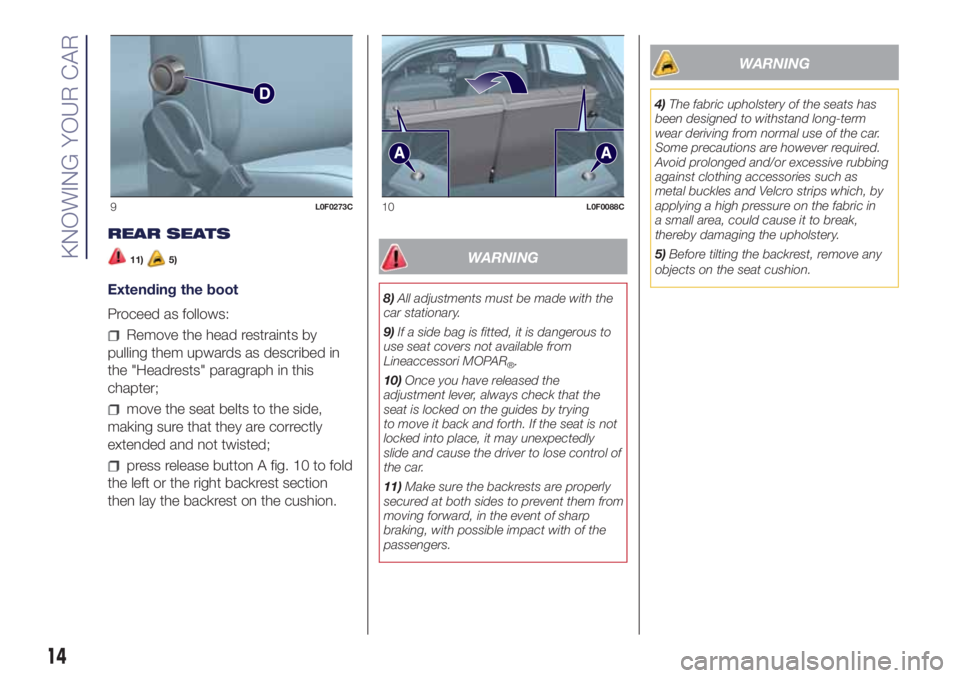
REAR SEATS
11)5)
Extending the boot
Proceed as follows:
Remove the head restraints by
pulling them upwards as described in
the "Headrests" paragraph in this
chapter;
move the seat belts to the side,
making sure that they are correctly
extended and not twisted;
press release button A fig. 10 to fold
the left or the right backrest section
then lay the backrest on the cushion.
WARNING
8)All adjustments must be made with the
car stationary.
9)If a side bag is fitted, it is dangerous to
use seat covers not available from
Lineaccessori MOPAR
®.
10)Once you have released the
adjustment lever, always check that the
seat is locked on the guides by trying
to move it back and forth. If the seat is not
locked into place, it may unexpectedly
slide and cause the driver to lose control of
the car.
11)Make sure the backrests are properly
secured at both sides to prevent them from
moving forward, in the event of sharp
braking, with possible impact with of the
passengers.
WARNING
4)The fabric upholstery of the seats has
been designed to withstand long-term
wear deriving from normal use of the car.
Some precautions are however required.
Avoid prolonged and/or excessive rubbing
against clothing accessories such as
metal buckles and Velcro strips which, by
applying a high pressure on the fabric in
a small area, could cause it to break,
thereby damaging the upholstery.
5)Before tilting the backrest, remove any
objects on the seat cushion.
9L0F0273C10L0F0088C
14
KNOWING YOUR CAR
Page 36 of 200

In Italy, the tank has a life of 10 years
starting from the car registration date. If
the vehicle has been registered in a
country other than Italy, the duration
and the testing/inspection procedures
of the LPG tank can vary depending on
the national provisions in force in that
country. In any case, when the time limit
in the individual country has run out,
contact a Lancia Dealership to have the
tank replaced.SELECTION OF
PETROL/LPG SUPPLY
TYPE
30)17) 18) 19) 19) 20) 21)
The petrol/LPG switch A fig. 38 allows
drivers to select petrol or LPG
operation.
To guarantee switching in full safety, the
actual change to the chosen fuel
system takes place depending on the
car usage conditions; it may not
therefore be immediate. Switching is
confirmed by the switching on/off of the
icon on the display.
If the LPG runs out, switching to petrol
takes place automatically. In this case
the display shows the
icon just
above the LPG wording and all the bars
of the edges for the empty notches
light up constantly.REFUELLING
22)
Maximum refuelling capacity (including
reserve): 30.5 litres. The figure already
takes into account the 80% tank filling
limit and the residual fluid required
for priming; this figure represents the
maximum permitted capacity. In
addition, after different refuelling
processes, this figure may vary due to
differences between the network pump
supply pressures, pumps having
different supply/locking features, tank
not completely run out of fuel.
WARNING
29)Note that in some countries (including
Italy) there are legal restrictions in force
for parking/garaging motor vehicles fuelled
by gas that is denser than air; LPG comes
under this category.
30)Do not switch between the two
operating modes whilst starting the engine.
37L0F0243C
38L0F0411C
34
KNOWING YOUR CAR
Page 38 of 200
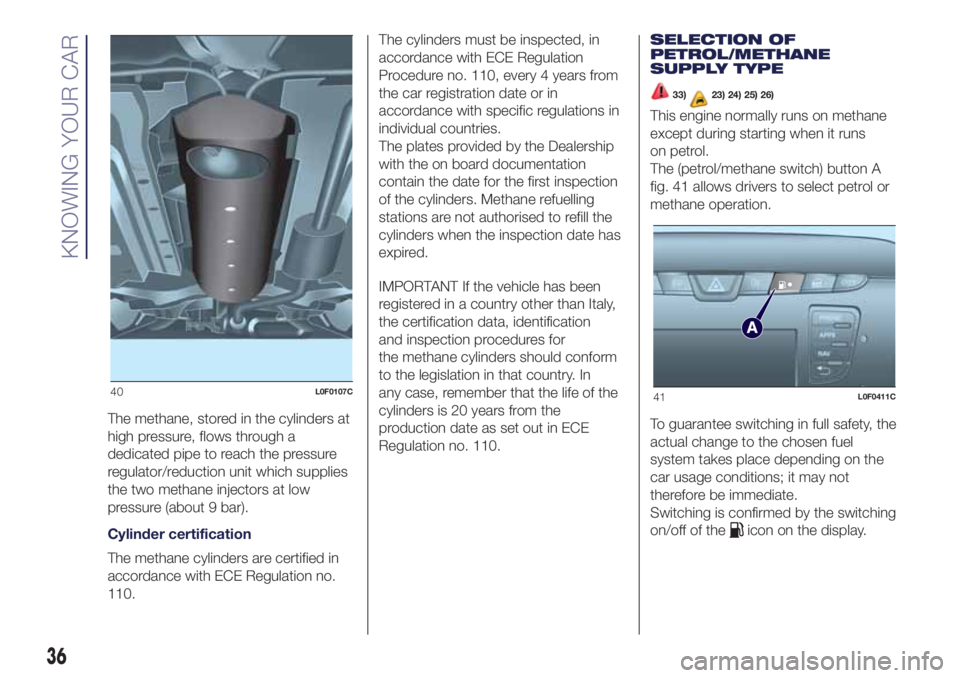
The methane, stored in the cylinders at
high pressure, flows through a
dedicated pipe to reach the pressure
regulator/reduction unit which supplies
the two methane injectors at low
pressure (about 9 bar).
Cylinder certification
The methane cylinders are certified in
accordance with ECE Regulation no.
110.The cylinders must be inspected, in
accordance with ECE Regulation
Procedure no. 110, every 4 years from
the car registration date or in
accordance with specific regulations in
individual countries.
The plates provided by the Dealership
with the on board documentation
contain the date for the first inspection
of the cylinders. Methane refuelling
stations are not authorised to refill the
cylinders when the inspection date has
expired.
IMPORTANT If the vehicle has been
registered in a country other than Italy,
the certification data, identification
and inspection procedures for
the methane cylinders should conform
to the legislation in that country. In
any case, remember that the life of the
cylinders is 20 years from the
production date as set out in ECE
Regulation no. 110.SELECTION OF
PETROL/METHANE
SUPPLY TYPE
33)23) 24) 25) 26)
This engine normally runs on methane
except during starting when it runs
on petrol.
The (petrol/methane switch) button A
fig. 41 allows drivers to select petrol or
methane operation.
To guarantee switching in full safety, the
actual change to the chosen fuel
system takes place depending on the
car usage conditions; it may not
therefore be immediate.
Switching is confirmed by the switching
on/off of the
icon on the display.
40L0F0107C41L0F0411C
36
KNOWING YOUR CAR
Page 39 of 200
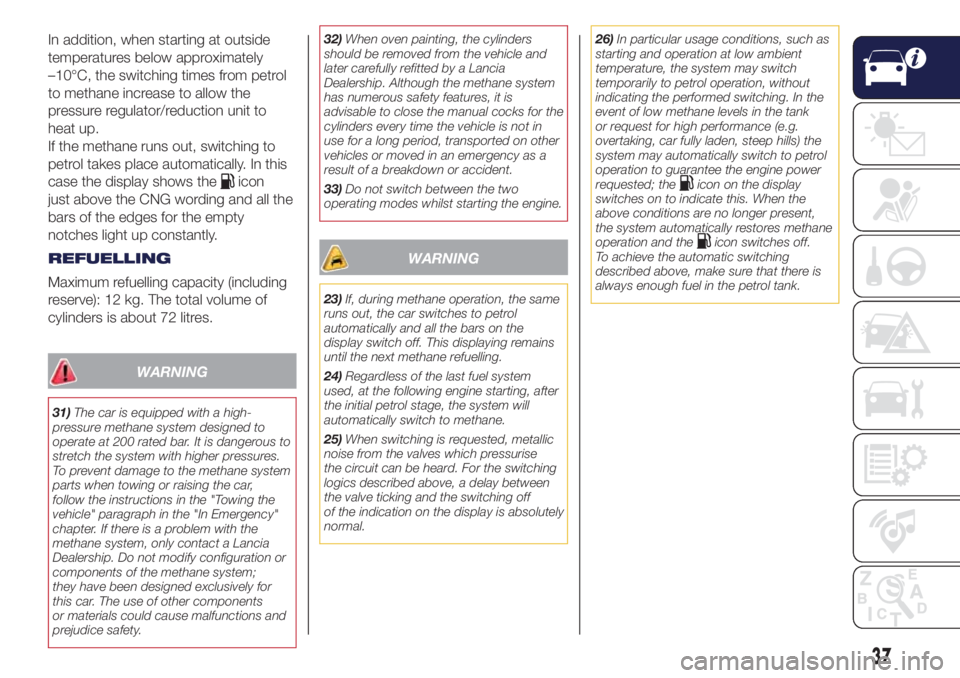
In addition, when starting at outside
temperatures below approximately
–10°C, the switching times from petrol
to methane increase to allow the
pressure regulator/reduction unit to
heat up.
If the methane runs out, switching to
petrol takes place automatically. In this
case the display shows the
icon
just above the CNG wording and all the
bars of the edges for the empty
notches light up constantly.
REFUELLING
Maximum refuelling capacity (including
reserve): 12 kg. The total volume of
cylinders is about 72 litres.
WARNING
31)The car is equipped with a high-
pressure methane system designed to
operate at 200 rated bar. It is dangerous to
stretch the system with higher pressures.
To prevent damage to the methane system
parts when towing or raising the car,
follow the instructions in the "Towing the
vehicle" paragraph in the "In Emergency"
chapter. If there is a problem with the
methane system, only contact a Lancia
Dealership. Do not modify configuration or
components of the methane system;
they have been designed exclusively for
this car. The use of other components
or materials could cause malfunctions and
prejudice safety.32)When oven painting, the cylinders
should be removed from the vehicle and
later carefully refitted by a Lancia
Dealership. Although the methane system
has numerous safety features, it is
advisable to close the manual cocks for the
cylinders every time the vehicle is not in
use for a long period, transported on other
vehicles or moved in an emergency as a
result of a breakdown or accident.
33)Do not switch between the two
operating modes whilst starting the engine.
WARNING
23)If, during methane operation, the same
runs out, the car switches to petrol
automatically and all the bars on the
display switch off. This displaying remains
until the next methane refuelling.
24)Regardless of the last fuel system
used, at the following engine starting, after
the initial petrol stage, the system will
automatically switch to methane.
25)When switching is requested, metallic
noise from the valves which pressurise
the circuit can be heard. For the switching
logics described above, a delay between
the valve ticking and the switching off
of the indication on the display is absolutely
normal.26)In particular usage conditions, such as
starting and operation at low ambient
temperature, the system may switch
temporarily to petrol operation, without
indicating the performed switching. In the
event of low methane levels in the tank
or request for high performance (e.g.
overtaking, car fully laden, steep hills) the
system may automatically switch to petrol
operation to guarantee the engine power
requested; the
icon on the display
switches on to indicate this. When the
above conditions are no longer present,
the system automatically restores methane
operation and the
icon switches off.
To achieve the automatic switching
described above, make sure that there is
always enough fuel in the petrol tank.
37
Page 43 of 200

DISPLAY
Multifunctional display
The following information is shown on
the display fig. 44:
A - Date
B - Gear Shift Indicator (for versions/
markets where provided)
C - Start&Stop function indicator (for
versions/markets where provided)
D - Time (always displayed, even with
key removed and doors closed)
E - Milometer (distance travelled in
kilometres/miles)
F - Outside temperature
G - Headlight alignment position (only
with dipped headlights on)
H - Dualdrive electric power steering
(CITY indication) or of ECO driving
mode (ECO indication) onReconfigurable multifunction
display
The following information is shown on
the display fig. 45:
A-Time
B - Date or trip distance display in
kilometres (or miles)
C - Gear Shift Indicator (for versions/
markets where provided)
D - Start&Stop function indicator (for
versions/markets where provided)
E - Milometer (distance travelled in
kilometres/miles)
F - Headlight alignment position (only
with dipped headlights on)
G - Outside temperature
H - Car status warning (e.g. doors
open, possible ice on road, etc.)
On some versions the display shows
the turbine pressure.GEAR SHIFT INDICATOR
The GSI (Gear Shift Indicator) system
advises the driver to change gear
through a specific indication on the
control panel.
Through the GSI, the driver is notified
that changing gear will allow a
reduction in fuel consumption.
When the SHIFT UP icon (
SHIFT) is
shown on the display, the GSI advises
the driver to engage a higher gear,
while when the SHIFT DOWN icon (
SHIFT) is shown, the GSI advises the
driver to engage a lower gear.
The indication on the instrument panel
remains until the driver shifts gear or the
driving conditions return to a situation
where gearshifting is not required to
improve consumption.
CONTROL BUTTONS
They are located on the dashboard fig.
46.
44L0F1008C
45L0F1007C
46L0F0414C
41
Page 50 of 200
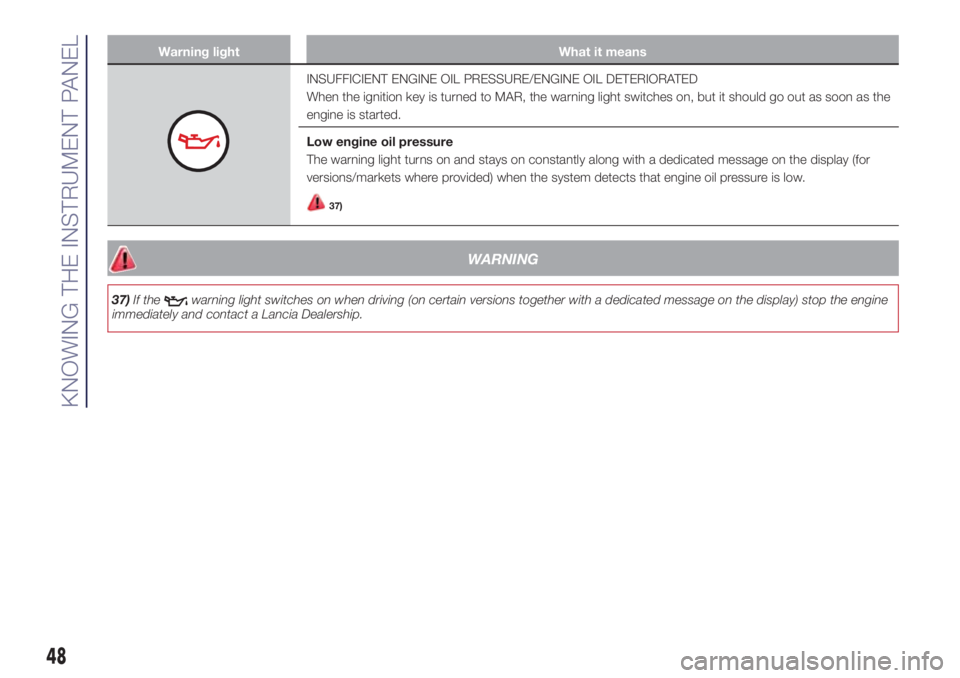
Warning light What it means
INSUFFICIENT ENGINE OIL PRESSURE/ENGINE OIL DETERIORATED
When the ignition key is turned to MAR, the warning light switches on, but it should go out as soon as the
engine is started.
Low engine oil pressure
The warning light turns on and stays on constantly along with a dedicated message on the display (for
versions/markets where provided) when the system detects that engine oil pressure is low.
37)
WARNING
37)If thewarning light switches on when driving (on certain versions together with a dedicated message on the display) stop the engine
immediately and contact a Lancia Dealership.
48
KNOWING THE INSTRUMENT PANEL
Page 60 of 200

Warning light What it means
Parking sensor fault(for versions/markets where provided)
The warning light (or symbol for versions with multifunction reconfigurable display) switches on together
with a dedicated message on the display, when a parking sensors fault is detected.
Dusk sensor fault(for versions/markets where provided)
The warning light (or symbol for versions with multifunction reconfigurable display) switches on together
with a dedicated message on the display, when a dusk sensor fault is detected.
Engine oil pressure sensor failure
The engine oil pressure sensor fault is signalled by the warning light (or symbol for versions with
reconfigurable multifunction display) on the instrument panel that switches on.
Airbag warning light fault(for versions/markets where provided)
The warning light (or symbol for versions with multifunction reconfigurable display) switches on flashing
when a fault is detected on the
warning light.
Tyre pressure monitoring system (iTPMS) not available
The warning light (or symbol for versions with multifunction reconfigurable display) switches on together
with a dedicated message on the display, to indicate that the tyre pressure monitoring system (iTPMS) is
not available.
58
KNOWING THE INSTRUMENT PANEL
Page 61 of 200
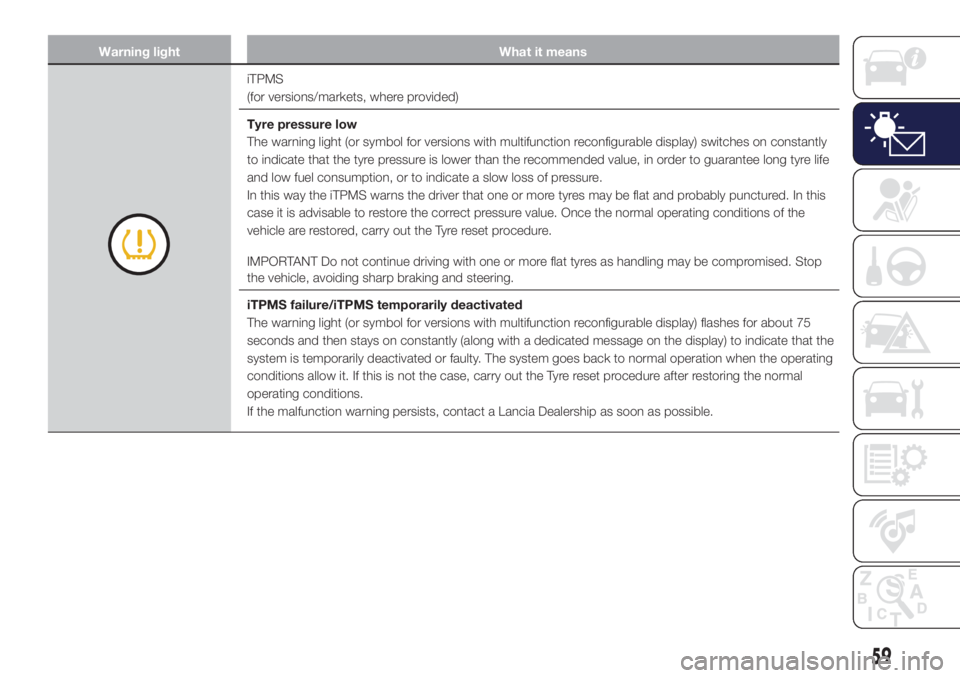
Warning light What it means
iTPMS
(for versions/markets, where provided)
Tyre pressure low
The warning light (or symbol for versions with multifunction reconfigurable display) switches on constantly
to indicate that the tyre pressure is lower than the recommended value, in order to guarantee long tyre life
and low fuel consumption, or to indicate a slow loss of pressure.
In this way the iTPMS warns the driver that one or more tyres may be flat and probably punctured. In this
case it is advisable to restore the correct pressure value. Once the normal operating conditions of the
vehicle are restored, carry out the Tyre reset procedure.
IMPORTANT Do not continue driving with one or more flat tyres as handling may be compromised. Stop
the vehicle, avoiding sharp braking and steering.
iTPMS failure/iTPMS temporarily deactivated
The warning light (or symbol for versions with multifunction reconfigurable display) flashes for about 75
seconds and then stays on constantly (along with a dedicated message on the display) to indicate that the
system is temporarily deactivated or faulty. The system goes back to normal operation when the operating
conditions allow it. If this is not the case, carry out the Tyre reset procedure after restoring the normal
operating conditions.
If the malfunction warning persists, contact a Lancia Dealership as soon as possible.
59
Page 68 of 200
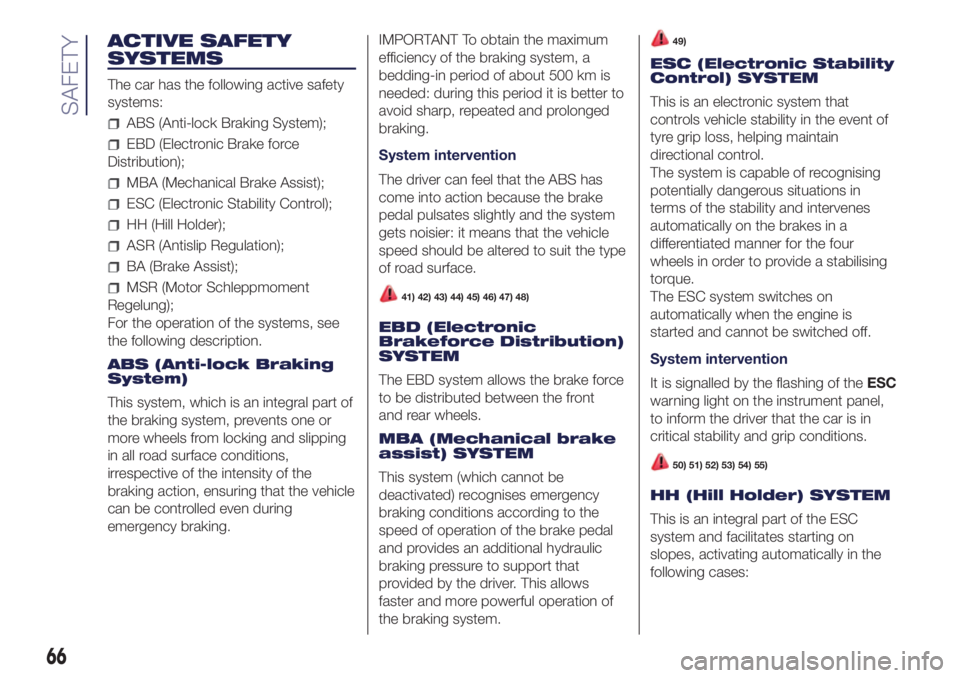
ACTIVE SAFETY
SYSTEMS
The car has the following active safety
systems:
ABS (Anti-lock Braking System);
EBD (Electronic Brake force
Distribution);
MBA (Mechanical Brake Assist);
ESC (Electronic Stability Control);
HH (Hill Holder);
ASR (Antislip Regulation);
BA (Brake Assist);
MSR (Motor Schleppmoment
Regelung);
For the operation of the systems, see
the following description.
ABS (Anti-lock Braking
System)
This system, which is an integral part of
the braking system, prevents one or
more wheels from locking and slipping
in all road surface conditions,
irrespective of the intensity of the
braking action, ensuring that the vehicle
can be controlled even during
emergency braking.IMPORTANT To obtain the maximum
efficiency of the braking system, a
bedding-in period of about 500 km is
needed: during this period it is better to
avoid sharp, repeated and prolonged
braking.
System intervention
The driver can feel that the ABS has
come into action because the brake
pedal pulsates slightly and the system
gets noisier: it means that the vehicle
speed should be altered to suit the type
of road surface.41) 42) 43) 44) 45) 46) 47) 48)
EBD (Electronic
Brakeforce Distribution)
SYSTEM
The EBD system allows the brake force
to be distributed between the front
and rear wheels.
MBA (Mechanical brake
assist) SYSTEM
This system (which cannot be
deactivated) recognises emergency
braking conditions according to the
speed of operation of the brake pedal
and provides an additional hydraulic
braking pressure to support that
provided by the driver. This allows
faster and more powerful operation of
the braking system.
49)
ESC (Electronic Stability
Control) SYSTEM
This is an electronic system that
controls vehicle stability in the event of
tyre grip loss, helping maintain
directional control.
The system is capable of recognising
potentially dangerous situations in
terms of the stability and intervenes
automatically on the brakes in a
differentiated manner for the four
wheels in order to provide a stabilising
torque.
The ESC system switches on
automatically when the engine is
started and cannot be switched off.
System intervention
It is signalled by the flashing of theESC
warning light on the instrument panel,
to inform the driver that the car is in
critical stability and grip conditions.
50) 51) 52) 53) 54) 55)
HH (Hill Holder) SYSTEM
This is an integral part of the ESC
system and facilitates starting on
slopes, activating automatically in the
following cases:
66
SAFETY
Page 69 of 200
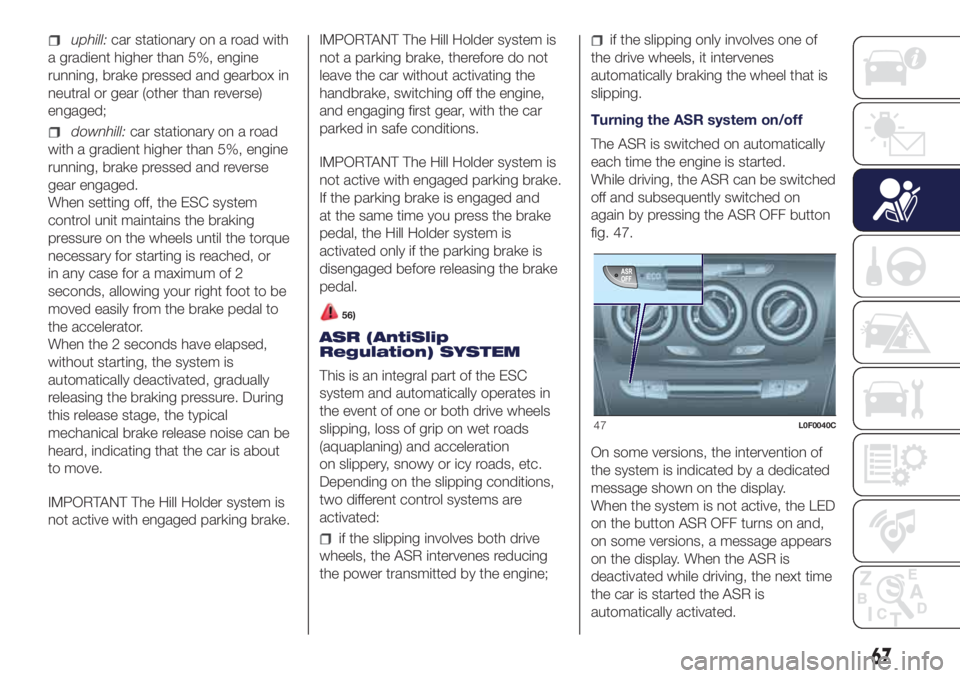
uphill:car stationary on a road with
a gradient higher than 5%, engine
running, brake pressed and gearbox in
neutral or gear (other than reverse)
engaged;
downhill:car stationary on a road
with a gradient higher than 5%, engine
running, brake pressed and reverse
gear engaged.
When setting off, the ESC system
control unit maintains the braking
pressure on the wheels until the torque
necessary for starting is reached, or
in any case for a maximum of 2
seconds, allowing your right foot to be
moved easily from the brake pedal to
the accelerator.
When the 2 seconds have elapsed,
without starting, the system is
automatically deactivated, gradually
releasing the braking pressure. During
this release stage, the typical
mechanical brake release noise can be
heard, indicating that the car is about
to move.
IMPORTANT The Hill Holder system is
not active with engaged parking brake.IMPORTANT The Hill Holder system is
not a parking brake, therefore do not
leave the car without activating the
handbrake, switching off the engine,
and engaging first gear, with the car
parked in safe conditions.
IMPORTANT The Hill Holder system is
not active with engaged parking brake.
If the parking brake is engaged and
at the same time you press the brake
pedal, the Hill Holder system is
activated only if the parking brake is
disengaged before releasing the brake
pedal.
56)
ASR (AntiSlip
Regulation) SYSTEM
This is an integral part of the ESC
system and automatically operates in
the event of one or both drive wheels
slipping, loss of grip on wet roads
(aquaplaning) and acceleration
on slippery, snowy or icy roads, etc.
Depending on the slipping conditions,
two different control systems are
activated:
if the slipping involves both drive
wheels, the ASR intervenes reducing
the power transmitted by the engine;
if the slipping only involves one of
the drive wheels, it intervenes
automatically braking the wheel that is
slipping.
Turning the ASR system on/off
The ASR is switched on automatically
each time the engine is started.
While driving, the ASR can be switched
off and subsequently switched on
again by pressing the ASR OFF button
fig. 47.
On some versions, the intervention of
the system is indicated by a dedicated
message shown on the display.
When the system is not active, the LED
on the button ASR OFF turns on and,
on some versions, a message appears
on the display. When the ASR is
deactivated while driving, the next time
the car is started the ASR is
automatically activated.
47L0F0040C
67